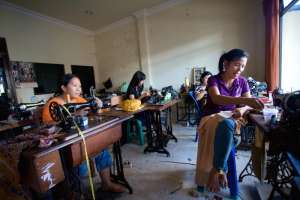
Concerns about moderating economic growth and rising income inequality in ASEAN economies have brought small and medium-sized enterprises (SMEs) into the policy limelight. Arguing that SMEs have significant potential for creating jobs, some commentators are suggesting a host of industrial policies such as financial subsidies and local content rules to promote SMEs. However, government failure may result from heavy-handed state intervention for SMEs.
An alternative is to reform SME finance—particularly by commercial banks—in ASEAN economies.
SMEs make up most of the enterprises, 74% of total employment and about 41% of gross domestic product in ASEAN economies. But these contributions are not reflected in trade, where SMEs account for only 21% of direct exports across the ASEAN region. Today, trade increasingly means global supply chain trade, which is about being involved in factories across the world, and trading in parts and components. Since the 1980s, ASEAN’s participation in supply chains accounts for a sizeable part of its respectable 5-6% annual economic growth. ASEAN economies, though, will face competition from India, Bangladesh and other new entrants in the future due to moderating regional growth and rising costs.
Adjusting business strategies and reforming commercial bank finance are critical to expand ASEAN’s role in supply chain trade – and firm size matters. Being a big firm naturally creates advantages to participate in supply chains due to a larger scale of production, better access to technology from abroad, and capacity to pay higher wages for skilled labor and spend more on marketing. Smart business strategies such as mergers, acquisitions, and forming business alliances with multinationals or large local business houses are all rational approaches.
Under some circumstances, nimble SMEs in ASEAN economies can also join supply chains. By clubbing together in industrial clusters, SMEs can overcome some of the disadvantages of their small size and rely on the benefits of interdependence. For instance, small firms located in clusters can jointly finance a training center or a technical consultant to upgrade skills. Business associations can facilitate clustering by mitigating trust deficits to cooperation among SMEs, and by coordinating collective actions.
Financial systems in ASEAN economies are dominated by a few commercial banks. One critical constraint affecting SMEs in ASEAN economies interested in supply chains is their lack of access to finance from commercial banks, although the credit gap seems greater in poorer economies like Cambodia, Lao PDR, and Myanmar. Banks in ASEAN economies typically undertake more certain and profitable lending to consumers and big corporations. Accordingly, SMEs continue to rely on internal sources—their own savings, moneylenders, and non-bank instruments—for most of their financial needs.
So what needs to be done to improve the situation?

1. Expand banking systems. ASEAN economies should continue to encourage the creation of sound and effective banking systems to increase the supply of finance including to SMEs. Encouraging competition among commercial banks is vital, through privatization of state banks and facilitating the entry of reputable foreign financial firms. Enacting competition laws provides a level playing field for domestic and foreign financial institutions alike, and effective central bank regulation of commercial banks are pre-requisites for deep financial systems.
2. Change collateral laws. Commercial banks lend little to SMEs, partly because many banks are not designed to do so. Commercial banks may not know how to properly evaluate the working capital requirements of SMEs and their investment projects, so we could allow using non-fixed collateral, and work with business associations to ratchet up peer pressure. In SME clusters in Japan, peer pressure within a network of SMEs is effective in getting businesses to pay back their loans.
3. Invest in financial literacy. Commercial banks require business and financial plans, but many SMEs that really need credit do not have the capacity to prepare these plans. SMEs use a single-entry accounting system, while banks expect to see something more complex. Investing in financial literacy for SME entrepreneurs and managers is therefore crucial. Financial literacy programs in high schools and universities, along with short financial literacy courses for SME managers, would be ideal.
4. Improve credit assessment for SMEs. Many ASEAN economies lack independent market institutions capable of rating SME credit worthiness. Establishing a domestic credit bureau for SMEs as a public-private partnership is a useful way forward. Later this institution could become an independent company.
A more effective system of commercial bank finance for SMEs in ASEAN is better than a plethora of industrial policies for SMEs. There are no quick fixes to reforming commercial bank financing of SMEs, and the process will take some time and require political will. But this can be a good start.
This article was first published by ADB Development Blog.







Comments are closed.